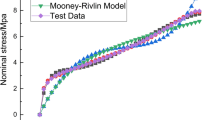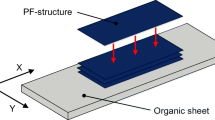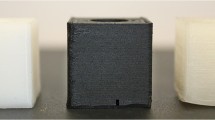Abstract
Due to the layer-by-layer nature of additive manufacturing, fabricated parts suffer from an anisotropic behavior with reduced mechanical performance when compared to traditional manufacturing. One specific mechanical property, folding endurance, requires both low flexural strength and simultaneously high elongation to achieve the flexibility needed to sustain repetitive bending. The present work provides an analysis of selected thermoplastics’ flexural capacity, including nylon (PA), polyethylene terephthalate (PETG), polylactide (PLA), thermoplastic polyurethane (TPU), polypropylene (PP), polyethylene (PE), and a TPR blend (ABSMG94: SEBS-g-MA 25:75), in order to evaluate the maximum number of folding cycles and load capacity sustained by a living hinge. A fractographic analysis was performed using scanning electron microscopy and computed tomography. Similar to the performance of injected molded products, the experimental results demonstrated that three of the tested materials behaved well in the context of a large number of folding cycles prior to an eventual detachment into two pieces; TPR blend, 244,424 cycles; PP endured one million cycles; and TPU, more than two million cycles, while the remaining materials failed to survive more than 1000 cycles. The hinges failure analysis revealed a wide variety of fracture morphologies and failure modes. In regard to the load capacity, PLA, PETG, and nylon provided the highest results in the ultimate strength of an axial static force applied (790.61 N, 656.06 N, and 652.75 N respectively), while the TPR blend was the highest (398.44 N) of the elastomeric materials (PP, TPU, and TPR blend). The evaluated materials demonstrated enough flexibility for use in specific applications such as stretchable electronics and wearable applications.



















Similar content being viewed by others
References
Melnikova R, Ehrmann A, Finsterbusch K (2014) 3D printing of textile-based structures by fused deposition modelling (FDM) with different polymer materials. IOP Conf Ser Mater Sci Eng 62:012018
Irwin MD, Roberson DA, Olivas RI, Wicker RB, MacDonald E (2011) Conductive polymer-coated threads as electrical interconnects in e-textiles. Fibers Polym 12:904–910
Rocío R, Ruiz-Huerta L, Almanza-Arjona YC et al (2017) Nanocomposites for additive manufacturing. Am J Chem Res 1:1–14
Spahiu T, Piperi E, Grimmelsmann N et al (2016) 3D printing as a new technology for apparel designing and manufacturing. In: International Textile Conference
MacDonald E, Wicker R (2016) Multiprocess 3D printing for increasing component functionality. Science 353:aaf2093. https://doi.org/10.1126/science.aaf2093
Muth JT, Vogt DM, Truby RL, Mengüç Y, Kolesky DB, Wood RJ, Lewis JA (2014) Embedded 3D printing of strain sensors within highly stretchable elastomers. Adv Mater 26:6307–6312
Cao Q, Kim H-S, Pimparkar N, Kulkarni JP, Wang C, Shim M, Roy K, Alam MA, Rogers JA (2008) Medium-scale carbon nanotube thin-film integrated circuits on flexible plastic substrates. Nature 454:495–500
Ko SH, Pan H, Grigoropoulos CP, Luscombe CK, Fréchet JMJ, Poulikakos D (2007) All-inkjet-printed flexible electronics fabrication on a polymer substrate by low-temperature high-resolution selective laser sintering of metal nanoparticles. Nanotechnology 18:345202
Ahn J-H, Kim H-S, Lee KJ, Jeon S, Kang SJ, Sun Y, Nuzzo RG, Rogers JA (2006) Heterogeneous three-dimensional electronics by use of printed semiconductor nanomaterials. Science 314:1754–1757
Telfer S, Munguia J, Pallari J, Dalgarno K, Steultjens M, Woodburn J (2014) Personalized foot orthoses with embedded temperature sensing: proof of concept and relationship with activity. Med Eng Phys 36:9–15
Ma RR, Odhner LU, Dollar AM (2013) A modular, open-source 3D printed underactuated hand. In: 2013 IEEE International Conference on Robotics and Automation
Lipson H (2014) Challenges and opportunities for design, simulation, and fabrication of soft robots. Soft Rob 1:21–27
Umedachi T, Vikas V, Trimmer BA (2013) Highly deformable 3-D printed soft robot generating inching and crawling locomotions with variable friction legs. In: 2013 IEEE/RSJ International Conference on Intelligent Robots and Systems
Rossiter J, Walters P, Stoimenov B (2009) Printing 3D dielectric elastomer actuators for soft robotics. In: Electroactive Polymer Actuators and Devices (EAPAD) 2009
Bartlett NW, Tolley MT, Overvelde JTB, Weaver JC, Mosadegh B, Bertoldi K, Whitesides GM, Wood RJ (2015) SOFT ROBOTICS. A 3D-printed, functionally graded soft robot powered by combustion. Science 349:161–165
Croccolo D, De Agostinis M, Olmi G (2013) Experimental characterization and analytical modelling of the mechanical behaviour of fused deposition processed parts made of ABS-M30. Comput Mater Sci 79:506–518
Torrado Perez AR, Roberson DA, Wicker RB (2014) Erratum to: Fracture surface analysis of 3D-printed tensile specimens of novel ABS-based materials. J Fail Anal Prev 14:549–549
Bellini A, Güçeri S (2003) Mechanical characterization of parts fabricated using fused deposition modeling. Rapid Prototyp J 9:252–264
Es-Said OS, Foyos J, Noorani R, Mendelson M, Marloth R, Pregger BA (2000) Effect of layer orientation on mechanical properties of rapid prototyped samples. Mater Manuf Process 15:107–122
Bagsik A, Schöppner V, Klemp E (2010) FDM part quality manufactured with Ultem* 9085. In: DMRC (ed) International Science Conference Polymeric Materials
Torrado AR, Shemelya CM, English JD, Lin Y, Wicker RB, Roberson DA (2015) Characterizing the effect of additives to ABS on the mechanical property anisotropy of specimens fabricated by material extrusion 3D printing. Addit Manuf 6:16–29
Lee CS, Kim SG, Kim HJ, Ahn SH (2007) Measurement of anisotropic compressive strength of rapid prototyping parts. J Mater Process Technol 187-188:627–630
Wu W, Geng P, Li G, Zhao D, Zhang H, Zhao J (2015) Influence of layer thickness and raster angle on the mechanical properties of 3D-printed PEEK and a comparative mechanical study between PEEK and ABS. Materials 8:5834–5846
Lee BH, Abdullah J, Khan ZA (2005) Optimization of rapid prototyping parameters for production of flexible ABS object. J Mater Process Technol 169:54–61
Vega V, Clements J, Lam T et al (2010) The effect of layer orientation on the mechanical properties and microstructure of a polymer. J Mater Eng Perform 20:978–988
Roberson DA, Torrado Perez AR, Shemelya CM, Rivera A, MacDonald E, Wicker RB (2015) Comparison of stress concentrator fabrication for 3D printed polymeric izod impact test specimens. Addit Manuf 7:1–11
Balderrama-Armendariz CO, MacDonald E, Espalin D, Cortes-Saenz D, Wicker R, Maldonado-Macias A (2018) Torsion analysis of the anisotropic behavior of FDM technology. Int J Adv Manuf Technol 96:307–317. https://doi.org/10.1007/s00170-018-1602-0
Torres J, Cotelo J, Karl J, Gordon AP (2015) Mechanical property optimization of FDM PLA in shear with multiple objectives. JOM 67:1183–1193
ASTM (2007) Standard test method for folding endurance of paper by the M.I.T. tester. ASTM International
International Organization for Standardization (1993) Test method for folding endurance of paper by the M.I.T. tester. ISO
Mraz S (2004) Care and feeding of living hinges. In: Machine design. http://www.machinedesign.com/fasteners/care-and-feeding-living-hinges. Accessed 29 May 2018
USP (2017) Polypropylene hinge. In: United States Plastic Corp. https://www.usplastic.com/search/default.aspx?it=item&keyword=Polypropylene%20Hinge
Siqueiros JG, Gilberto Siqueiros J, Schnittker K, Roberson DA (2016) ABS-maleated SEBS blend as a 3D printable material. Virtual Phys Prototyp 11:123–131
Meng Q, Li Y, Xu J (2013) New empirical stiffness equations for corner-filleted flexure hinges. Mech Sci 4:345–356
Dirksen F, Lammering R (2011) On mechanical properties of planar flexure hinges of compliant mechanisms. Mech Sci 2:109–117
Zhu Z, Zhou X, Wang R, Liu Q (2014) A simple compliance modeling method for flexure hinges. Sci China Technol Sci 58:56–63
Smyth CT (2017) Functional design for 3D printing: designing 3D printed things for everyday use, 3rd edn
ASTM Committee F42 on Additive Manufacturing Technologies, ASTM Committee F42 on Additive Manufacturing Technologies. Subcommittee F42.01 on Test Methods, Technical Committee ISO/TC 261, Additive Manufacturing (2013) Standard terminology for additive manufacturing--coordinate systems and test methodologies
Engel L (1981) An atlas of polymer damage: surface examination by scanning electron microscope, Wiley-Blackwell
Acknowledgments
The research presented here was conducted in the Rapid Prototyping Lab at the Universidad Autónoma de Ciudad Juárez (Autonomous University of Ciudad Juarez) in Collaboration with The University of Texas at El Paso (UTEP) in the W.M. Keck Center for 3D Innovation. The Friedman Chair for Manufacturing at Youngstown State University also supported the work.
Funding
Funding for this work was provided by the AFOSR through the Young Investigator Program (YIP) under grant number FA9550-14-1-0260 and the Defense University Instrumentation Program (DURIP) under grant number FA9550-15-1-0312.
Author information
Authors and Affiliations
Corresponding author
Additional information
Publisher’s note
Springer Nature remains neutral with regard to jurisdictional claims in published maps and institutional affiliations.
Rights and permissions
About this article
Cite this article
Balderrama-Armendariz, C.O., MacDonald, E., Roberson, D.A. et al. Folding behavior of thermoplastic hinges fabricated with polymer extrusion additive manufacturing. Int J Adv Manuf Technol 105, 233–245 (2019). https://doi.org/10.1007/s00170-019-04196-x
Received:
Accepted:
Published:
Issue Date:
DOI: https://doi.org/10.1007/s00170-019-04196-x




